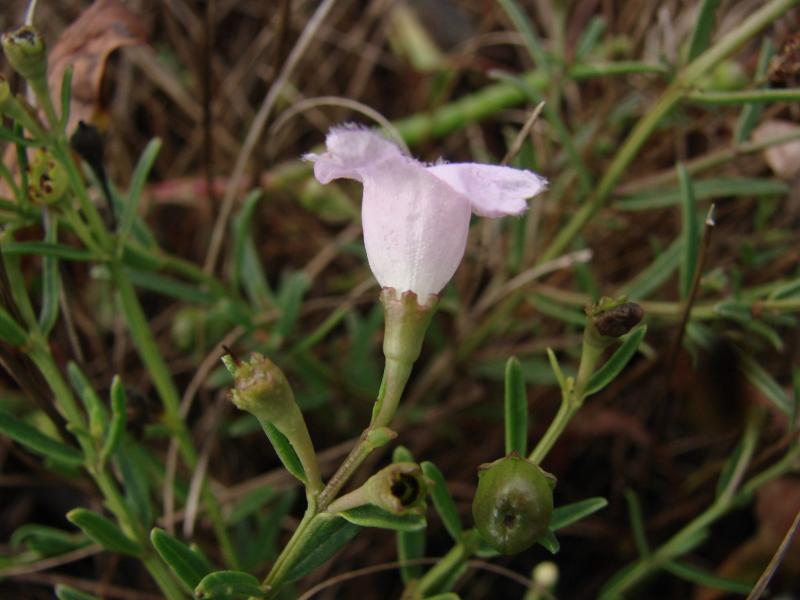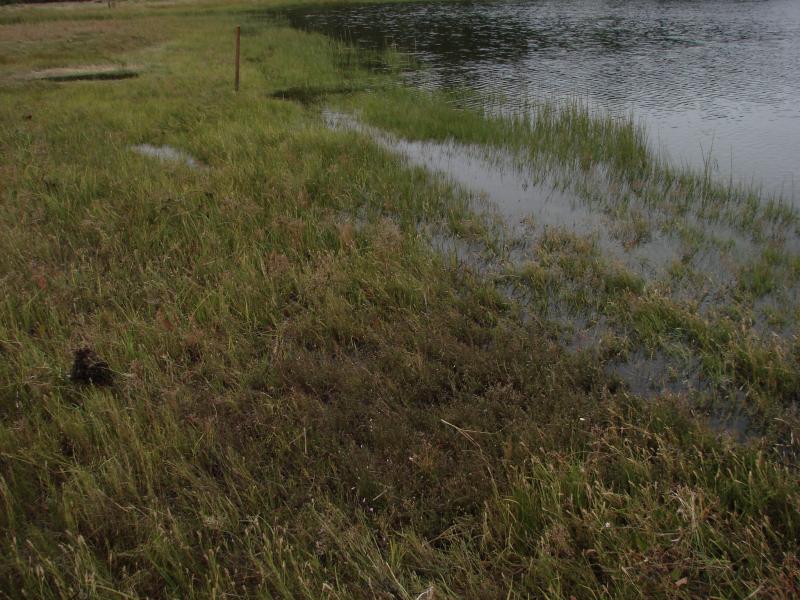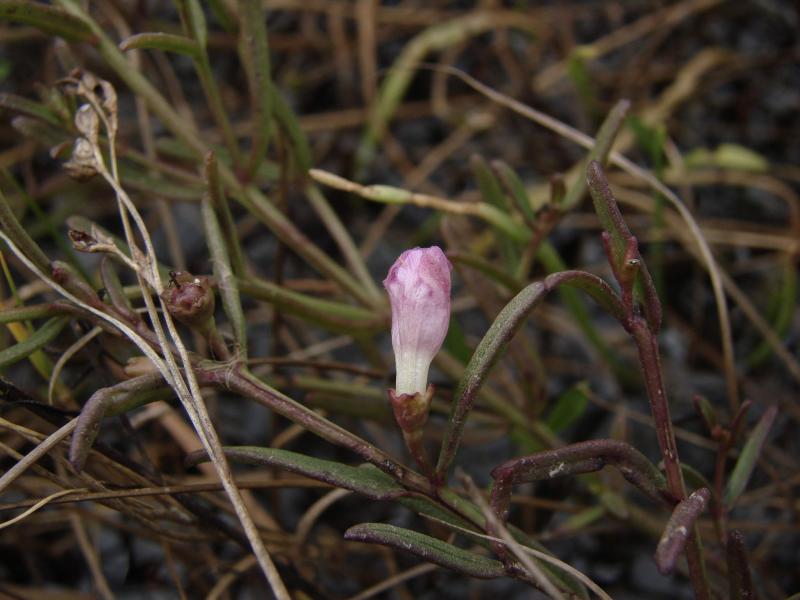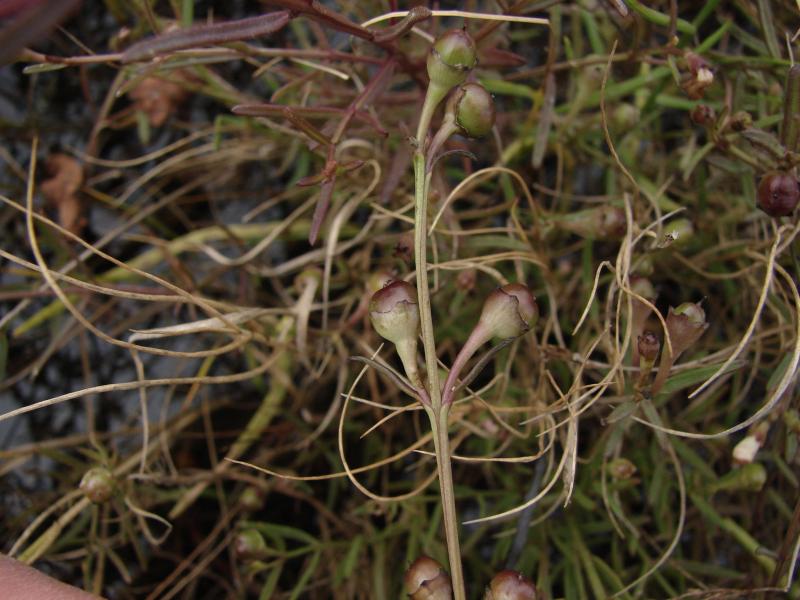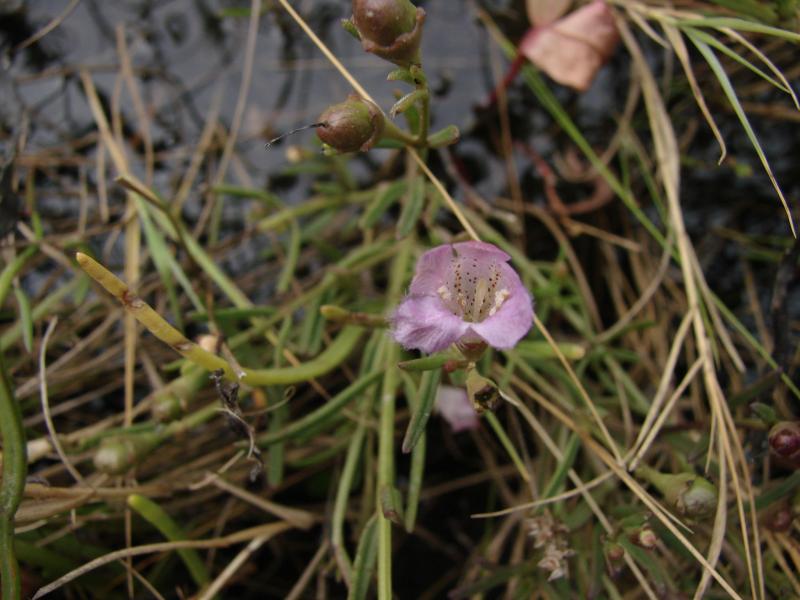Seaside Agalinis
Agalinis maritima var. maritima None
- Class
- Dicotyledoneae (Dicots)
- Family
- Orobanchaceae (Broom-Rape Family)
- State Protection
- Threatened
Listed as Threatened by New York State: likely to become Endangered in the foreseeable future. For animals, taking, importation, transportation, or possession is prohibited, except under license or permit. For plants, removal or damage without the consent of the landowner is prohibited.
- Federal Protection
- Not Listed
- State Conservation Status Rank
- S2S3
Imperiled or Vulnerable in New York - Very vulnerable, or vulnerable, to disappearing from New York, due to rarity or other factors; typically 6 to 80 populations or locations in New York, few individuals, restricted range, few remaining acres (or miles of stream), and/or recent and widespread declines. More information is needed to assign either S2 or S3.
- Global Conservation Status Rank
- G5T5
Secure globally - Both the species as a whole and the subspecies/variety are common in the world; widespread and abundant (but may be rare in some parts of its range).
Summary
Did you know?
Even though this species is now only seen along the coast of Long Island, Seaside gerardia was reported from the inland salt marshes of Onondaga County in the early 1900s (Goodrich 1912). These salt marshes were eventually eliminated by development and Phragmites.
State Ranking Justification
There are eight existing populations and most of them have hundreds of plants. One population has hundreds of thousands of plants. There are many populations that have not been searched in over 30 years and this may result in more populations being found.
Short-term Trends
Populations may be diminishing because of Phragmites invasion.
Long-term Trends
There has been a substantial decline in the number of populations over the last 100 years because saltmarshes have been drained and manipulated. Phragmites has also eliminated some populations.
Conservation and Management
Threats
The plants occur in salt marshes that are subject to ditching and invasion by Phragmites. Phragmites is the larger and more immediate threat.
Conservation Strategies and Management Practices
Control Phragmites invasions in the salt marshes where it exists and prevent new incursions. Natural buffers should be established around the salt marshes to decrease pollution runoff and other direct human disturbances.
Research Needs
There are many saltmarshes on Long Island so why does this plant only occur in a few of them? A study of in the habitat requirements of this plant is needed.
Habitat
Habitat
Seaside Gerardia grows, as well it should, near the ocean. In New York it has most often been found in sparsely vegetated areas within and around the edges of high salt marsh, and occasionally in other tidal zones such as low salt marsh or brackish tidal marsh (New York Natural Heritage Program 2010). Salt marshes (Gleason and Cronquist 1991, Haines 1998).
Associated Ecological Communities
- Brackish tidal marsh
(guide)
A marsh community that occurs where water salinity ranges from 0.5 to 18.0 ppt, and water is less than 2 m (6 ft) deep at high tide. The vegetation in a brackish tidal marsh is dense and dominated by tall grass-like plants.
- High salt marsh
(guide)
A coastal marsh community that occurs in sheltered areas of the seacoast, in a zone extending from mean high tide up to the limit of spring tides. It is periodically flooded by spring tides and flood tides. High salt marshes typically consist of a mosaic of patches that are mostly dominated by a single graminoid species.
Associated Species
- Amaranthus cannabinus (salt marsh water-hemp)
- Argentina egedii
- Atriplex prostrata (seaside orach)
- Baccharis halimifolia (groundsel-tree)
- Bolboschoenus robustus (sea-coast bulrush)
- Distichlis spicata (salt grass)
- Fimbristylis castanea (marsh fimbry)
- Lilaeopsis chinensis (eastern grasswort)
- Limonium carolinianum (sea-lavender)
- Phragmites australis ssp. australis
- Plantago maritima var. juncoides (seaside plantain)
- Pluchea odorata (salt marsh-fleabane)
- Polygonum glaucum (sea-beach knotweed)
- Quercus
- Salicornia depressa (slender glasswort)
- Schoenoplectus americanus (chair-maker's bulrush)
- Schoenoplectus pungens
- Schoenoplectus tabernaemontani (soft-stemmed bulrush)
- Spartina alterniflora (smooth cord grass)
- Spartina patens (salt-meadow cord grass)
- Symphyotrichum tenuifolium
- Triglochin maritima (sea arrow-grass)
Range
New York State Distribution
This species is known only from Suffolk County on eastern Long Island although historically it ranged west to New York City and Westchester County where it is now extirpated.
Global Distribution
Agalinis maritima var. maritima occurs along the coastal plain from southern Maine to North Carolina.
Identification Comments
General Description
Seaside gerardia is an annual wildflower species growing up to 35 centimeters tall. The thick, succulent leaves are linear, 2 to 3 cm long and only 2 mm wide. The flowers are light purple or pink, arranged in pairs growing out of the axils of the upper leaves. They are 5-petaled, bell-shaped with spreading tips, 1.2 to 2 centimeters long, and marked with dark purple dots on the inside. The fruits are rounded capsules 5 to 6 mm long, containing brown seeds. As is true for our other Gerardia species, each flower opens for only a single day. When not in flower these plants may be inconspicuous amongst the often taller salt marsh vegetation (Gleason and Cronquist 1991, Haines 1998).
Best Life Stage for Proper Identification
Seaside Gerardia is most easily identified when in flower.
Similar Species
Seaside Gerardia is the only species of Agalinis in New York with rounded sepals that are obtuse or rounded at the tips. Other species have triangular or awl-shaped sepals with sharp-pointed tips. It is also the only New York Agalinis normally found in salt marshes.
Best Time to See
Seaside gerardia flowers in late August or September. The fruits can persist through November.
- Vegetative
- Flowering
- Fruiting
The time of year you would expect to find Seaside Agalinis vegetative, flowering, and fruiting in New York.
Seaside Agalinis Images
Taxonomy
Seaside Agalinis
Agalinis maritima var. maritima None
- Kingdom Plantae
- Phylum Anthophyta
- Class Dicotyledoneae
(Dicots)
- Order Scrophulariales
- Family Orobanchaceae (Broom-Rape Family)
- Order Scrophulariales
- Class Dicotyledoneae
(Dicots)
- Phylum Anthophyta
Additional Common Names
- Saltmarsh Gerardia
- Seaside Gerardia
Synonyms
- Gerardia maritima Raf.
Comments on the Classification
All of our Agalinis maritima are variety maritima.
Additional Resources
Best Identification Reference
Gleason, Henry A. and A. Cronquist. 1991. Manual of Vascular Plants of Northeastern United States and Adjacent Canada. The New York Botanical Garden, Bronx, New York. 910 pp.
Other References
Crow, Garrett E. 1982. New England's Rare, Threatened, and Endangered Plants. Prepared for the United States Department of Interior, Fish and Wildlife Service, Northeast Region. June 1982.
Goodrich, L.L.H. 1912. Flora of Onondaga County. Syracuse, New York. 210 pp.
Holmgren, Noel. 1998. The Illustrated Companion to Gleason and Cronquist's Manual. Illustrations of the Vascular Plants of Northeastern United States and Adjacent Canada. The New York Botanical Garden, Bronx, New York.
Mitchell, Richard S. and Charles J. Sheviak. 1981. Rare Plants of New York State. Bull No. 445. New York State Museum. Univ. of New York. State Ed. Department Albany, NY.
Mitchell, Richard S. and Gordon C. Tucker. 1997. Revised Checklist of New York State Plants. Contributions to a Flora of New York State. Checklist IV. Bulletin No. 490. New York State Museum. Albany, NY. 400 pp.
New York Natural Heritage Program. 2024. New York Natural Heritage Program Databases. Albany, NY.
Weldy, T. and D. Werier. 2010. New York flora atlas. [S.M. Landry, K.N. Campbell, and L.D. Mabe (original application development), Florida Center for Community Design and Research http://www.fccdr.usf.edu/. University of South Florida http://www.usf.edu/]. New York Flora Association http://newyork.plantatlas.usf.edu/, Albany, New York
Links
About This Guide
This guide was authored by: Stephen M. Young
Information for this guide was last updated on: September 6, 2012
Please cite this page as:
New York Natural Heritage Program. 2024.
Online Conservation Guide for
Agalinis maritima var. maritima.
Available from: https://guides.nynhp.org/seaside-agalinis/.
Accessed July 27, 2024.
